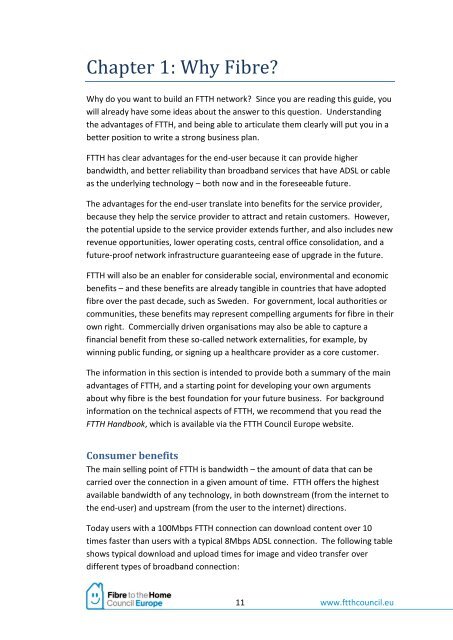You also want an ePaper? Increase the reach of your titles
YUMPU automatically turns print PDFs into web optimized ePapers that Google loves.
Chapter 1: Why Fibre?<br />
Why do you want to build an <strong>FTTH</strong> network? Since you are reading this guide, you<br />
will already have some ideas about the answer to this question. Understanding<br />
the advantages of <strong>FTTH</strong>, and <strong>be</strong>ing able to articulate them clearly will put you in a<br />
<strong>be</strong>tter position to write a strong business plan.<br />
<strong>FTTH</strong> has clear advantages for the end-user <strong>be</strong>cause it can provide higher<br />
bandwidth, and <strong>be</strong>tter reliability than broadband services that have ADSL or cable<br />
as the underlying technology – both now and in the foreseeable future.<br />
The advantages for the end-user translate into <strong>be</strong>nefits for the service provider,<br />
<strong>be</strong>cause they help the service provider to attract and retain customers. However,<br />
the potential upside to the service provider extends further, and also includes new<br />
revenue opportunities, lower operating costs, central office consolidation, and a<br />
future-proof network infrastructure guaranteeing ease of upgrade in the future.<br />
<strong>FTTH</strong> will also <strong>be</strong> an enabler for considerable social, environmental and economic<br />
<strong>be</strong>nefits – and these <strong>be</strong>nefits are already tangible in countries that have adopted<br />
fibre over the past decade, such as Sweden. For government, local authorities or<br />
communities, these <strong>be</strong>nefits may represent compelling arguments for fibre in their<br />
own right. Commercially driven organisations may also <strong>be</strong> able to capture a<br />
financial <strong>be</strong>nefit from these so-called network externalities, for example, by<br />
winning public funding, or signing up a healthcare provider as a core customer.<br />
The information in this section is intended to provide both a summary of the main<br />
advantages of <strong>FTTH</strong>, and a starting point for developing your own arguments<br />
about why fibre is the <strong>be</strong>st foundation for your future business. For background<br />
information on the technical aspects of <strong>FTTH</strong>, we recommend that you read the<br />
<strong>FTTH</strong> Handbook, which is available via the <strong>FTTH</strong> Council Europe website.<br />
Consumer <strong>be</strong>nefits<br />
The main selling point of <strong>FTTH</strong> is bandwidth – the amount of data that can <strong>be</strong><br />
carried over the connection in a given amount of time. <strong>FTTH</strong> offers the highest<br />
available bandwidth of any technology, in both downstream (from the internet to<br />
the end-user) and upstream (from the user to the internet) directions.<br />
Today users with a 100Mbps <strong>FTTH</strong> connection can download content over 10<br />
times faster than users with a typical 8Mbps ADSL connection. The following table<br />
shows typical download and upload times for image and video transfer over<br />
different types of broadband connection:<br />
11 www.ftthcouncil.eu

















